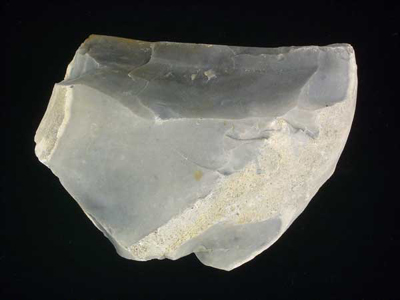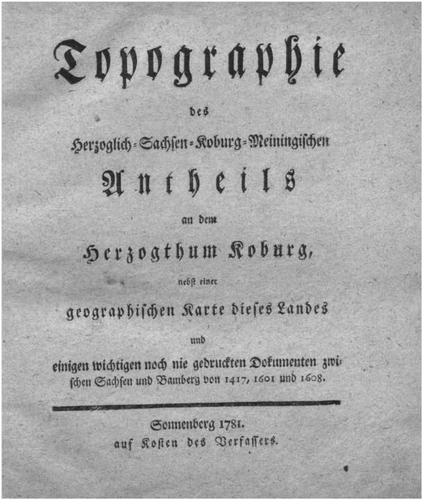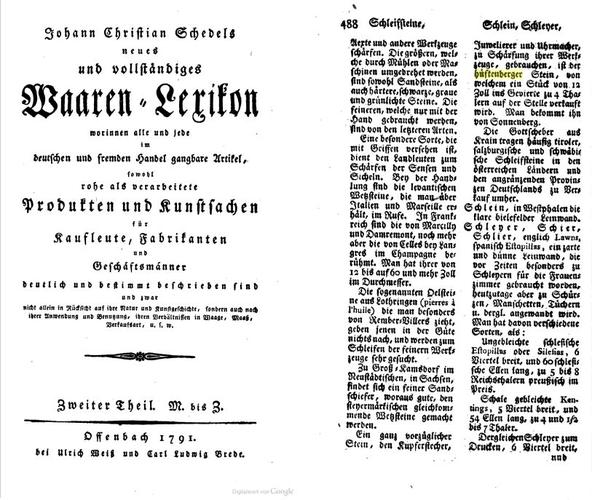Results 11 to 20 of 41
-
08-25-2013, 04:57 PM #11Senior Member



- Join Date
- Apr 2008
- Location
- Essex, UK
- Posts
- 3,816
Thanked: 3164
Ah, I see. A kind of 20 questions quiz!
I understand that they are from the same place as thuringians that we know as waterstones, but not the importance of the contrast of stone type. After all, thuringian waterstones are far removed from the ash/clay/chalk etc sedimentary deposits (which incidentally were laid down in the Ordovician period) that through a process of sedimtation-compaction-metamorphosis formed shales and schists and finally the waterstones we know and use.
That stones of a completely different nature are found within sedimentary layers and have a more adamantine nature is only natural - further metamorphosis has once again changed the nature of the layers that were once just a lot of loose uncompacted mud and grit.
Such fornations can be produced by shear forces or the proximity of great heat, as in Wales where we find a particularly long seam of harder rock amongst the softer slate. Here we find slatestone, lyn idwal, grecian oilstone and possibly the mythical cutlers greenstone.
Ordovician hones are by no means rare. The honing slates at Melynllyn and those from the caradoc beds were laid down in ordovician times. Ther are sandstone hones from York of the same period. Some are even older of course, hailing back to cambrian times.
To demystify the subject:
The Paleozoic age consisted of 7 eras, the 4 oldest being-
1 cambrian, 540-490 million years ago,
2 ordovician, 490-443
3 silurian, 443-417
4 devonian, 417-434
I have never seen the particular stone whose name I, along with my american friends, apparently cannot pronounce, but I did enjoy the quiz.
Regards,
Neil
-
08-25-2013, 06:23 PM #12

You are absolutely right Neil.
There are a lot of places in the world with Ordovician rocks. The same with upper devonian age places, there are thousands of deposits. But not any (known) place that provide the same quality of stones than the thuringian waterwhetstones.
I don’t want to say that all Ordovician age stones have a special sharpening or honing capability – I just use this distinguishing mark to separate the different thuringian whetstones.
I thought the history of the Ordovician thuringians could be an interesting item to hone experts of course not to newbies. That’s why I posted this thread, maybe with a misunderstanding or for some provoking title.
Also there is no mystic about this. I simply thought that someone talking about thuringian stones should know that there is much more to talk about than only the labeled Escher stones.
If this is not of interest – well that’s ok for me. I won’t post on this item here any more.
-
08-25-2013, 06:47 PM #13

Interesting rocks...
Quite frankly when I looked at the first picture you posted it reminded me a very common type of stone found all over America:

Chert (microcrystalline quartz) (SiO2) includes chalcedony, agate, jasper, and flint. Chert and flint are so similar that there is no sharp distinction between them. Dark-colored nodules are called flint, and the light-colored variety is called chert. The variation may be due to the inclusion of variable amounts of organic matter. Other chert colors can include pink, brown, and purple. Chert has a conchoidal fracture, a hardness of around 7, a dull luster, and a colorless streak.
Arrowheads were commonly crafted from chert.
Chert (microcrystalline quartz) (SiO2) includes chalcedony, agate, jasper, and flint. Chert and flint are so similar that there is no sharp distinction between them. Dark-colored nodules are called flint, and the light-colored variety is called chert. The variation may be due to the inclusion of variable amounts of organic matter. Other chert colors can include pink, brown, and purple. Chert has a conchoidal fracture, a hardness of around 7, a dull luster, and a colorless streak.
The irregular masses of chert that are common in Texas limestones may have been formed by silica-rich groundwater passing through the sediments before they were lithified (formed into rocks). These irregular masses, known as nodules, often have exotic shapes uninfluenced by the textures in the host limestone.Last edited by Wolfpack34; 08-25-2013 at 06:49 PM.
-
08-25-2013, 07:07 PM #14Senior Member



- Join Date
- Apr 2008
- Location
- Essex, UK
- Posts
- 3,816
Thanked: 3164
Oh no, please continue to post!
I just think the subject would have been better as a factual one right from the start, as a piece about ordovician thuringians.
The subject is divided enough as it is - being led to guess about something already known does not help IMO, but that is just wbat it says - only my opinion.
I love to find out more abot hones, and have thoroughly enjoyed your other posts, Hatzico, so I repeat: please carry on posting.
Regards,
NeilLast edited by Neil Miller; 08-25-2013 at 07:10 PM.
-
08-25-2013, 10:21 PM #15Senior Member

- Join Date
- Mar 2009
- Posts
- 1,211
Thanked: 202
Excellent reading. Thank you. Another piece to the memory. Now you can just hope that similar thing will happen to what happened to CF. First very rare and now when people know what to look for they are quite available.
Please continue.
-
08-26-2013, 09:40 AM #16Historically Inquisitive



- Join Date
- Aug 2011
- Location
- Upstate New York
- Posts
- 5,782
- Blog Entries
- 1
Thanked: 4249
Of course keep posting about it! very interesting to me anyway, not knowing i would a definately pass this stone up if ever by luck ran into one in the wild, now because of this thread i would act differently!
-
08-31-2013, 04:37 PM #17

To round off this thread I would like to add some older literature about the stones. The Hiftenberg stones are documented in a lot of ancient german literature of the 19th and also the 18th century.
The most detailed description of the Hiftenberg stones is found in the geographical description of the thuringian area by a famous geologist of this time.


An attempt for a translation:
"Near Sigmundsburg below the Hüfftenberger houses is a quarry of quite an excellent stone which is known under the name of the Hüfftenberger stone. He is not only usable to sharpen barber knife(straight razors), but also particularly for copperplate engravers, jewellers, watchmakers and those who work with grave sickles. Even the nature has marked him so that no mistake can be carried out, while every stone, it might be as big or small, has spots which look in such a way, as if a little piece of buckhorn was stuck to it. They are sold very expensive, a piece of 8 to 12 inches in the squares is well paid with 3 to 4 Thaler. Today they are hard to get, because the mining is under risk of one’s life as long as the mine is not timbered properly. There are two types in colour, bluish and yellowish ones, whereas the yellow ones are a little rarer latter than the blue ones because they were found only in certain depths."
The second article I would like to mention is a Ware lexicon that describes all used, imported and exported goods in Germany in the year 1791. On page 488 of this book you will find Whetstones.
As for finer stones to sharpen knifes and fine instruments (straight razor honing is not mentioned) you found Levantiner oilstones (turkey oilstones), French oilstones from Lothringen and the Hiftenberg stones. The text mentioning the Hiftenberg stones is comparable to what you can read in former mentioned literature.

Beside the Hiftenberg stones there are a lot of other - more or less- famous quarries of the Ordovician style hones and sharpening stones in Thuringia and the Frankonian area of Germany.
For example there is one quarry the Escher family rented for a long time.
As I have already mentioned in some other post, the Escher company did not rent or own any quarries for the Upper Devonian age whaterwhetstones till the beginning of the 20thcentury - the stones that made Escher famous. They purchased this stones from different thuringian whetstone companies, cut, lapped them and put a label on the stones and then imported the hones around the world, as Escher mainly was a trading company.
But the Escher company did had an Ordovician quarry from the beginning of their engagement with whetstones around 1790 till the early 20th. This may illustrate the importance of ordovician whetstones in the past.
-
The Following 5 Users Say Thank You to hatzicho For This Useful Post:
JimmyHAD (09-02-2013), Margeja (09-01-2013), Piet (08-31-2013), ScottGoodman (09-01-2013), Vasilis (09-29-2013)
-
08-31-2013, 11:25 PM #18

This is an excellent post. Unfortunately I feel like feel like I have been trying to drink from a fire hose. Definatly need to read this a few more times (and take notes).
The older I get the more I realize how little I actually know.
-
09-01-2013, 01:42 AM #19Senior Member




- Join Date
- Feb 2013
- Location
- Haida Gwaii, British Columbia, Canada
- Posts
- 14,443
Thanked: 4828
I'm very much interested in the natural hone. In part because I want to use them and in part because I want to find them. I have a little more research to do (ok a lot) and I'm going rock hounding.
-
09-01-2013, 02:14 PM #20aka shooter74743




- Join Date
- Sep 2009
- Location
- SE Oklahoma/NE Texas
- Posts
- 7,285
- Blog Entries
- 4
Thanked: 1936
Now that I understand the thread, I thank you for the information. I too thought it was a "what stone is this" thread, however it turned educational.
Now you must send me a stone to test so that I can put the added knowledge to the steel...Southeastern Oklahoma/Northeastern Texas helper. Please don't hesitate to contact me.
Thank you and God Bless, Scott


 43Likes
43Likes LinkBack URL
LinkBack URL About LinkBacks
About LinkBacks






 Reply With Quote
Reply With Quote
